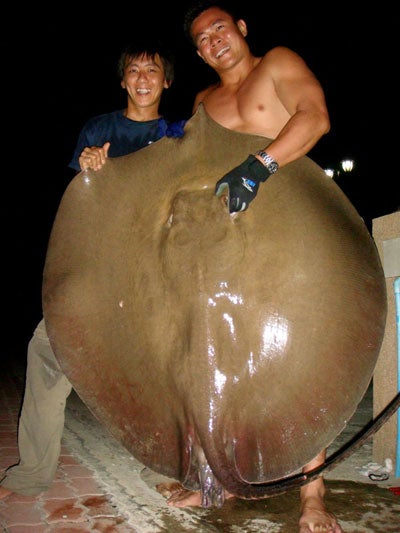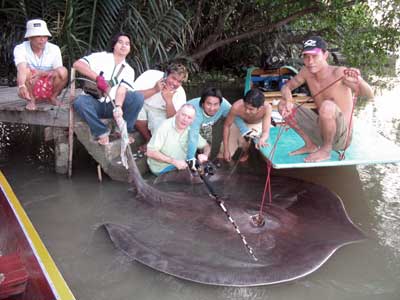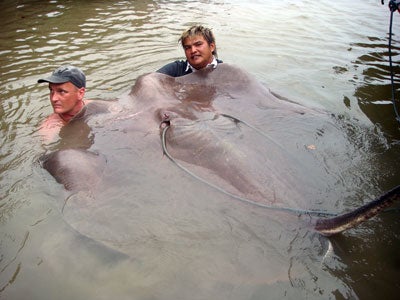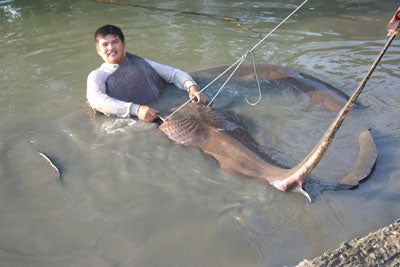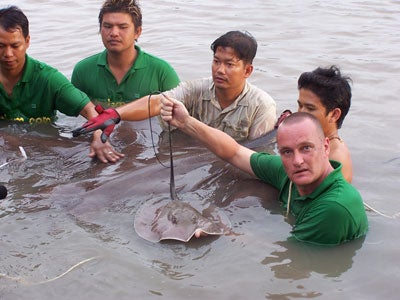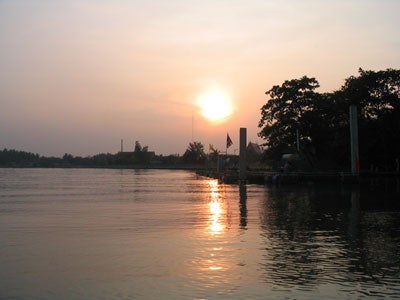The Giant Freshwater Stingray, truly a legendary fishHimantura Chaophraya, a Living FossilThe Giant Freshwater Stingray (Himantura Chaophraya) is found in various river systems throughout Thailand and S.E Asia and is reputed to reach weights exceeding 1,000lb (450kg) and is a serious contender for the largest freshwater fish on earth and is one of the least studied creatures on the planet. With very little known about this prehistoric predatory fish and very few documented captures it is truly a fish shrouded in folklore and legend.
The GFS was first formally described in 1989 and there has been very little scientific research concerning this mysterious prehistoric predator. DESCRIPTION: Stingray, Giant Freshwater. (Himantura Chaophraya). Max weight 450 kg+/ 1000lbs. Predatory. The Giant Freshwater Stingray (GFS) is the largest freshwater fish on the planet reaching weights approaching 1000 lbs. This prehistoric relic inhabits some of the wildest and remote waters on earth including the Mekong, Maeklong, Ban Pakong, Chaophraya, Tachin and Tapi Rivers in Thailand and is also distributed in Borneo, New Guinea and Australia. This nomadic and understudied ancient predator is one of the largest living Dasyatids (whip-rays) family of fishes left on the planet. The Giant Freshwater Stingray belongs to the class Chondrichthyes, which includes all 850 species of sharks, rays, skates, and chimaeras. These fishes have cruised the oceans since the Paleozoic era. The basic dorsoventrally compressed body plan of the ray is thought to have originated during the Jurassic period, approximately 100 Mya. This design, coupled with a lack of a swim bladder and powerful jaws designed for crushing hard shells of molluscs such as clams and mussels, has made the ray the successful benthic predator it is today. The GFS is found throughout the great river systems of Thailand in freshwater and estuarine enviroments and is possibly the largest freshwater fish on the planet. This mighty Paelozoic predator is easily identifiable due to its immense rounded disc-like shape measuring upto three metres in width with a prominent snout tip and whip-like tail. Within the central section of the disc the main body of the ray is located housing the fish’s internal organs and in some specimens displaying the endoskeleton of the creature. At the front of the pronounced body section small protruding ‘periscope’ eyes are located allowing it a limited field of vision of the water column above whilst buried in the muddy riverbed. Behind the eyes is the spiracle area often referred to as the ‘sixth gill’ which acts as a primitive type of snorkel. This adaptation allows them to breathe more easily while they are hiding in the substrate. The GFS has a dark brown surface on its upper/dorsal side with a highly abrasive textured skin covered in placoid scales, the tiny tooth-like structures that protect the skin of elasmobranchs and give it a sandpaper-like texture. The creature’s underside is of a very smooth nature characteristically white in colour with a grey to brown colouration around the edges. A huge cavernous mouth is located on the underside lined with highly abrasive crushing pads. Jelly-filled sensory pores “Ampullae of Lorenzini”, located on the skin around the nose and mouth on the underside of the disc, are present in most elasmobranchs and allow sharks and rays to detect minute electric fields generated by living things. This is especially useful for freshwater stingrays because it helps them to hunt down prey that might be buried in the riverbed or hiding in murky water. In addition two rows of five gill slits are located on the underside/ventral side of these prehistoric predatory giants. The Giant Freshwater Stingray is armed with two venomous barbs located close to the base of its tail which have two components: the sharp inner barb used for piercing, and a thin sheath surrounding it that contains the venom. When the spine is deployed, the barb pierces the venom sac along with the victim’s skin, and the poisonous slime is introduced into the wound. The barb is extremely sharp (it has been known to penetrate bone), and it operates under the same principle as an arrowhead – it slides into flesh fairly easily, but the serrated edges make it very difficult and painful to extract. The tail is very flexible and can bend pretty much any direction within a split second, inflicting serious damage. In addition to causing great pain, the venom contains enzymes that cause tissue death. Similarly to the teeth or dorsal spines of a shark, stingray spines are thought to have originated from placoid scales, the tiny tooth-like structures that protect the skin of elasmobranchs and give it a sandpaper-like texture. Placoid scales, just like shark teeth, are lost and re-grown on a regular basis. Determining the sex of these mighty living fossil’s is a relatively easy exercise with male specimens displaying obvious genitalia called claspers similar to those of a shark at the base of the tail. Female specimens are easily distinguishable by an absence of genitalia in this region. This king of freshwater predators preys on fish, crustaceans, mollusc’s and other aquatic invertebrates. Himantura Chaophraya is considered threatened and is listed as vulnerable on the IUCN red list.
The ultimate predator The GFS is the ultimate predatory fish and is arguably the largest freshwater fish in the world. In an exchange of information with Zeb Hogan, an emerging National geographic explorer and fish biologist that works for ‘mega fish project’, an organisation funded by WWF and other concerned organisations. The mega fish project can be seen at www.megafishes.org. I asked if the Himantura Chaophraya was indeed a true freshwater fish. Zeb informed me that it has never been confirmed and that it was possible these creatures might venture into marine waters.There are many unanswered questions concerning these highly mysterious underwater dinosaurs which swim in some of the wildest and most unexplored waters on Earth. In search of Giant Freshwater StingrayThe month of March 2007 was the start of an exciting new chapter in the creation of www.fishsiam.com, it would see us entering into a totally unexplored and pioneering style of angling on some of the wildest and most remote waters in S.E. Asia in search of the mighty GFS (Himantura Chaophraya).
After many months of exhaustive enquiries my partner Boy informed me that he had identified a stretch of this mammoth tidal river rumoured to hold this mythical creature. He had been told stories of GFS being landed by local fishermen after epic battles lasting many hours with unconfirmed weights in the excess of 100kg! The Maeklong RiverWe began our quest with a series of exploratory expeditions to the Maeklong River in Samut Songkran some 130km’s west of Bangkok. After several days spent at various parts of the river fishing with the use of a boat, nothing but a series of plastic bags had visited our rods and the doubts started creeping into my mind. We fished extremely hard, coinciding our visits with information obtained from tidal charts which revealed when the river would be at its highest.The Maeklong River is an extremely daunting piece of water and is affected by daily tidal influxes altering the depth and flow considerably. Huge dams one hundred kilometres upstream can also alter fishing conditions considerably even beating back the invading tides on occasions.
The Maeklong River is over 145 km long with widths approaching a mile in some parts which meanders through three provinces before finally ending its journey in the Gulf of Thailand. We would fish this daunting tidal river for the next three months adopting a mobile approach and fishing dozens of spots in the hope of hooking our elusive prey, catching nothing but small sea catfish and plastic bags! It would be some months later, on 24th July 2007 to be precise, before we would have our first encounter with a Giant Freshwater Stingray. Francois Pineau, a visiting angler and friend from French Guyana, joined Boy on a trip to the Maeklong River. Fishing near to the rivers mouth the anglers successfully hooked and landed a small juvenile GFS measuring a mere 10cm in width. This capture would be the start of our account on the Maeklong! We would continue to fish the Maeklong in earnest trying to find these elusive giants and found ourselves fishing a stretch of the river some 20km from the river mouth close to the bustling market town of Amphawa. This stretch had an extremely wide section and a series of wide sweeping bends with varying depths down to 18m. The start of a series of encountersAlmost two weeks after our first capture of GFS Boy returned to the Amphawa stretch with a Singaporean client capturing a specimen estimated to weigh 30kg. This capture would herald the start of a series of encounters with monster rays with various specimens caught reaching weights of 70-80kg.
It was during one of our many sessions on the Maeklong River that Boy informed me of another river reputed to hold GFS of an even larger size. The Ban Pakong River near Chachoengsao was said to have produced numerous giant rays with weights estimated to reach 200kg plus! Boy also informed me that he knew someone who had indeed captured such a fish and would be able to help us in our ongoing quest. Plans were made for an expedition to the Ban Pakong River at the next available opportunity. Tackle and heavy leads and a GFS of 70kg12th December 2007 saw Boy visiting the Ban Pakong River in the company of www.fishsiam.com, team member Ow. They were joined by Ohm, an extremely stocky local guy in his mid-twenties, and his good friend Q. Fishing on the Ban Pakong River was not unlike our efforts on the Maeklong with rigs being the same 120lb flouro leaders and large 7/0 Mustad circle hooks. Baits on the Ban Pakong River were to be boated out with the rods being fished from the riverbank. On hooking a fish the anglers would be required to use a boat and play out the battle from mid river. In addition larger leads of 500g-1kg were required to hold bottom in the increased flow.A large Giant Freshwater Stingray was captured and was estimated to weigh in the region of 70kg with another much larger unseen giant cutting through the leader with its highly abrasive tail. A decision was made to up the strength of the hooklink/leader. 250lb wire traces were purchased in readiness for our next visit to the river of the dragon!
Six days later the anglers returned to the same stretch of river and accounted for another prehistoric predator slightly larger than the last. The Ban Pakong was starting to pay dividends and we all agreed that it was only a matter of time until the river threw up something really special. Capture of a GFS of legendary proportionsBoxing Day 2007, saw our beliefs confirmed when Tom Parker a returning friend and client from Coventry captured a Giant Freshwater Stingray of legendary proportions. After an epic one hour battle a huge GFS with a wingspan of 2.4m was landed. The fish was estimated to weigh between 170-200kg making it the largest recorded example ever caught on rod and line in Asia and possibly only seconded by one other capture in South America. With the immense size of the creature and the vulnerable status afforded GFS by the IUCN it was not attempted to weigh the fish. This capture would attract numerous interest from various parties worldwide with enquiries from the WWF and the Southern Australian Museum, not to mention the varied exposure in the worldwide angling media.The New Year continued to see the Ban Pakong be kind to us and saw our friends and clients capturing several more specimens, with myself getting amongst the fish, capturing GFS to an estimated 120-130kg. The capture of my personal best Giant freshwater stingray was filmed by a Thai national news crew and saw over sixty local people journey to the riverbank to see this crazy foreigner and this ancient monster of the deep! Jaw-dropping sizeWith a wingspan of 1.8m this fish was truly a catch of a lifetime and was the culmination of a long year spent in search of Giant freshwater stingray on two of Thailand’s wildest and most remote tidal river systems. After my personal best capture I was told that this was just ‘medium size’ and that Ohm had photographs of a much larger GFS that he had captured three years previously. On inspection of the photos my jaw instantly hit the ground, pictured before me was the largest Giant Freshwater Stingray I have ever seen! God only knows how big this fish was! I will leave it up to you to make your own estimations regarding this mighty creature’s weight!
The fishsiam team continued to make expeditions to the Ban Pakong in the coming months with a succession of monster GFS gracing our rods with weights estimated to reach a whopping 180-200kg (2.2m). On a recent expedition accompanied by Dr.Zeb Hogan, (mega fishes project) we landed no less than four individual specimens with the largest being a heavily pregnant female which gave birth to a live newborn measuring a mere 34cm whilst being handled in the margins of the massive tidal river. Nat Geo news writer Stefan Lovgren filmed the events with Dr.Zeb Hogan making a short examination and photographs being taken. The ancient predator was released with its infant back to the murky waters of the mighty Ban Pakong River. At the time of writing the fishsiam team has accounted for 25 individual Giant Freshwater Stingrays from the Ban Pakong and Maeklong Rivers in Thailand and will be continuing our quest to capture the largest freshwater fish on the planet. Rick Humphreys 6th April 2008 |
Welcome!Log into your account










